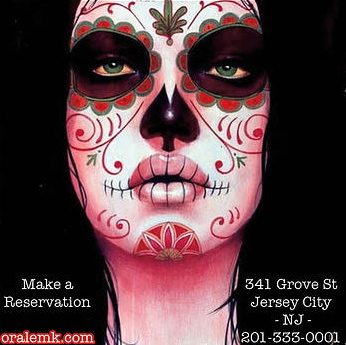
Whereas Halloween wants to be (sort of) scary, the Day of the Dead is surprisingly joyous, given its name, because it aims to reunite celebrants with the memory of loved ones who have passed on.
The tradition, initially a summer holiday, began hundreds of years ago in Mexico’s Aztec cultures, explains Louis Alvarez, one of Orale’s owners. European settlers moved the pagan ritual to coincide with the Catholic holidays of All Souls’ and All Saints’ days and helped to spread the idea to other countries.
Alvarez, 46, who was born in Ecuador and came to New Jersey at age 13, did not experience the holiday in his native land, but has seen its popularity spread during many years working in Latin restaurants.
“It just keeps elevating every year,” he says.
Central to the holiday is an elaborate altar honoring the deceased, displayed in private homes as well as public gathering spots, The belief, Alvarez says, is that “it will bring the souls back to celebrate with their loved ones on this day.”
Typically, the altar includes pictures of the departed, “some of the things the person liked, including food, tequila and cigars” and orange marigolds, the "flor de muerto," thought to attract the souls of the forebears.
Many Americans are familiar with Pan de Muertos, or Day of the Dead Bread, a sweet egg bread. It is sometimes baked with a tiny toy skeleton inside. “The person who gets it will have good luck,” says Alvarez.
Orale won’t be serving Day of the Dead bread, Alvarez says, because the sweetness doesn’t go with the rest of the menu. But the restaurant will display its Calaveras de Azúcar, life-sized skulls made of molded sugar, decorated with colorful icing and glitter and often inscribed with the name of the loved one. The skulls are brittle, not recommended for eating, but the sugar represents the sweetness of life, the skull the sadness of death.
At Orale as in the home, holiday main courses often include molé dishes of meat with rich, red or brown, chili-spiked sauces often flavored with bittersweet chocolate or a green pipian sauce made from pumpkin seeds and cilantro.
Sweets like arros con leche, a rice pudding, are paired with cookies.
The holiday’s iconic image is the La Calavera Catrina, a female skeleton given make-up and a fancy dress and hat. The figure first became popular at the turn of the 20th century after an image created by Mexican illustrator José Guadalupe Posada.
At Orale, there will be plenty of lively celebrating and dressing up from 5 pm until closing. A DJ will entertain from 5 to 6:30, with a live mariachi band following from 6:30 to 8, a DJ and dancing from 8 until closing. Face painting will be available from 6 to 8.
There will be plenty of margaritas, sangria and tequila cocktails to go around.
Guests are encouraged to bring their own photos of departed dear ones to display on their tables.
SUZANNE ZIMMER LOWERY is a food writer, pastry chef and culinary instructor at a number of New Jersey cooking schools. Find out more about her at suzannelowery.com.

